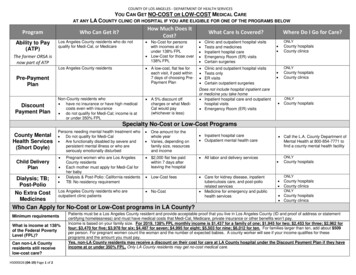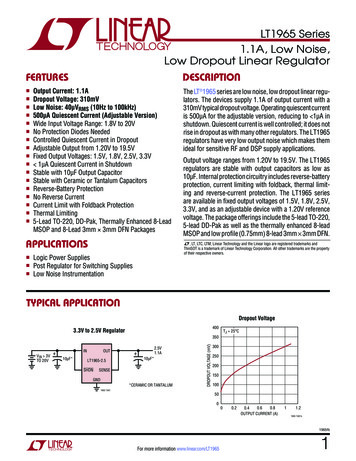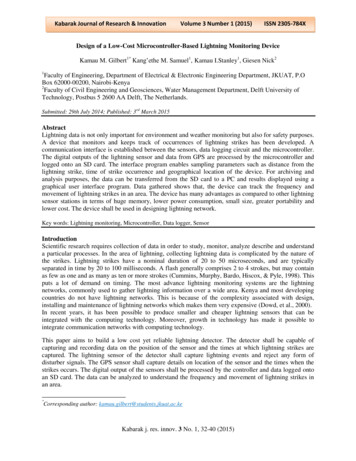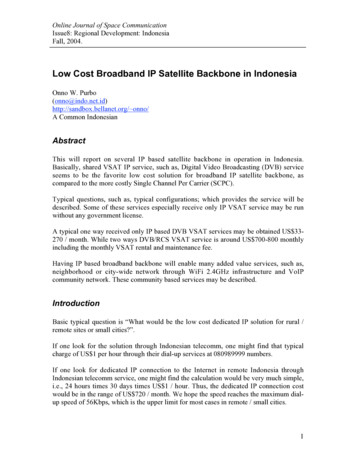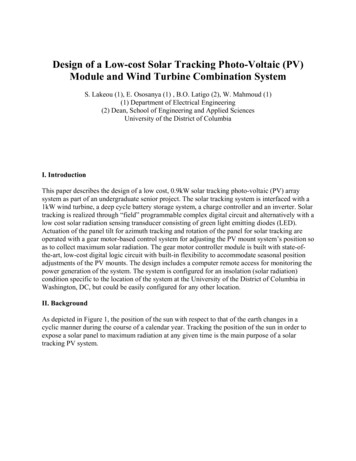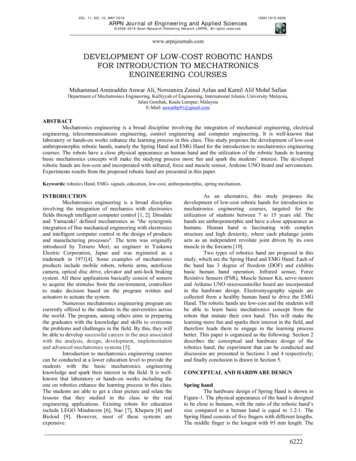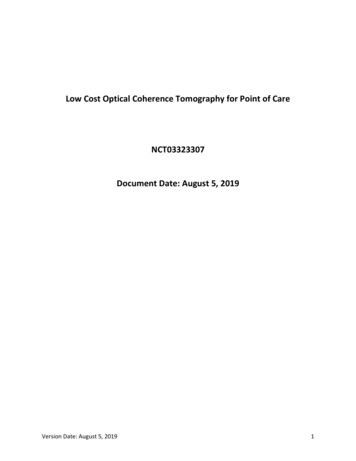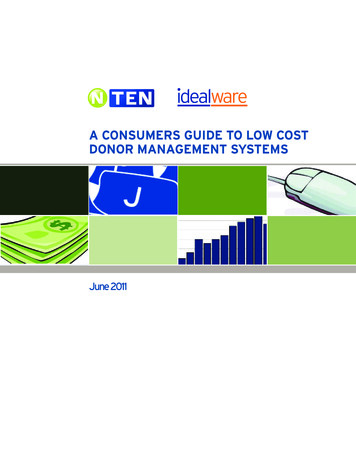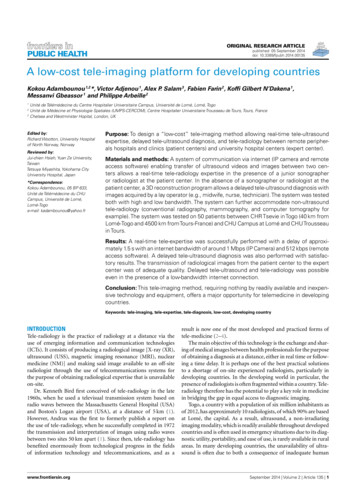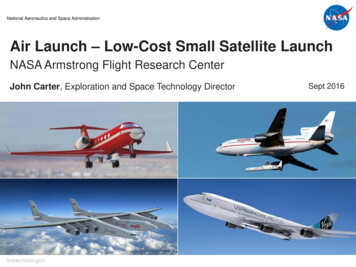
Transcription
National Aeronautics and Space AdministrationAir Launch – Low-Cost Small Satellite LaunchNASA Armstrong Flight Research CenterJohn Carter, Exploration and Space Technology Directorwww.nasa.govSept 2016
Armstrong (Dryden) Performed Many Air LaunchesFrom 1946-2010Summary Rocket-propelled flights Bell X-1through X-43 Total flight operations – 662 Total manned flight operations – 654Manned Flight –Rocket-powered operations(glide flights not included) 135 Bell X-1, 23 Bell X-1A, 25 Bell X-1B,24 Bell X-1E 134 Douglas Skyrocket D-558-2 198 North American X-15 115 lifting bodies (M2-F2, M2-F3,HL-10, X-24)Armstrong Flight Research CenterUnmanned –Rocket-powered operations 6 B-52/Orbital Sciences PegasusLaunches 2 B-52/X-43 Hyper-X (Mach 7 andMach 10)2
Performance Advantages/Disadvantages of Air LaunchPerformance advantages Launch vehicle starts with initial velocity and altitude compared to ground launch (typically Mach 0.8,40K ft) Air launch adds stages to launch vehicle, which lifts rest of launch vehicle to Mach 0.8, 40Kft›two-stage rocket becomes three-stage rocket, three-stage rocket becomes four-stage rocket, etc. Launch starts above denser lower atmosphere, decreased drag losses during first stage Lower trajectory-averaged atmospheric pressure during first stage, increased rocket thrust and specificimpulse Lower atmospheric pressure at launch, can use higher expansion ratio nozzles on first stage withoutflow separation, further increase in rocket thrust and specific impulsePerformance disadvantages Typically a wing needs to be added, with tail control surfaces (aka Pegasus configuration), to provide liftfor pull-up maneuver to rotate flight path angle from horizontal air launch to flight path angle needed forascent to orbit›Wing and tail surfaces add weight and drag, high angle-of-attack during pull-up maneuver increases drag losses›Parachutes or other methods to avoid adding wing typically lose altitude and velocity, first stage ignition altitude canfall to approximately 20K ft, velocity to zero or slightly negativeArmstrong Flight Research Center3
Air Launch at AFRCA number of new commercial companies are attempting very unique air launchoperations – AFRC has agreements for support (bold) and is negotiating with others Generation Orbit – Analysis of launch vehicle off a G-III Virgin Galactic – Analysis of LauncherOne vehicle off a 747 Vulcan – Flight test and technical support of Stratolaunch vehicle CubeCab – Satellite launch using an F-104 Other companies – Analysis of launch vehiclesStrong collaboration with the Federal Aviation Administration (FAA) Office ofCommercial Space Transportation (AST) for launch licenses Have had productive meetings discussing air launchArmstrong Flight Research Center4
Towed Glider Small Satellite Launch ConceptA remotely piloted glider, towed by a modified cargo/passenger jet, releasing a launch vehicle with payload at 48K’ 45K’,non-SBU M 0.75, up to a 700 flight path angle, safely and effectively.https://www.youtube.com/watch?v 0hEnYyykaL8Armstrong Flight Research Center5
Why Towed Glider?PerformanceCost Less expensive to build, operate, and maintainthan developing and building a one-of-a-kind,custom carry aircraft Simple glider, devoid of expensive, complexsystemsTowed Glider Air Launch performance advantagesover conventional horizontal air launch››› Glider with sustainer motor does pull-up maneuverrotating flight path angle before dropping launchvehicle, no need for wing on launch vehicle, onlysmall fixed fins for aerodynamic stability during 3 to5-second drop before first stage ignitionEliminates weight and drag from wing, fixed tail finshave reduced weight compared to moveable finsEliminates pull-up maneuver being performed bylaunch vehicle for decreased first stage drag lossescompared to horizontal air launchTowed Glider Air Launch performanceadvantages over ground launch››Has all air launch advantages listed on prior chart,with all air launch disadvantages eliminatedFrom Towed Glider Air Launch study in progress forDARPA, substantial increases in payload to orbitcompared to ground launch for two-stage liquid andmulti-stage solid launch vehiclesGeometry › No hydraulics, fuel system, engines, life support,egress systemsLeverages the advantages of air-launching›No dependence on critical ground based launchfacilities/assetsSafety Unmanned glider eliminates aircrew concernsfor carrying launch vehicle (LV) LV doesn’t have to be human-rated (blastproximity), nor does the gliderRisk A systems level integration of existing, proventechnologiesCan lift significantly larger payloads to altitudeversus modifying a same size, direct carry,“conventional” aircraft for external carriageArmstrong Flight Research Center6
Towed Glider Air Launch Study for DARPAStudy tasks Assess the viability of operating small (nanosatellite and larger) launch vehicles off the Towed Glider Calculate the performance increase for each launch vehicle launching from the Towed Glider comparedto ground launch Estimate the cost of performing a launch operation from the Towed Glider (excluding the cost of thelaunch vehicle) Multiple (proprietary) launch vehiclesPerformance analysis POST trajectories, missile DATCOM aero data, company mass properties dataSubstantial increases in payload to orbit compared to ground launch for two-stage liquidand multi-stage solid launch vehiclesTowed Glider operating costs 300K to 500K per launch Includes amortized cost of Towed Glider depreciated over number of flights Includes cost per flight of renting, or owning, the tow plane Does not include benefit of potential reduction in range costs Cheaper (potentially much cheaper) than adding an additional conventional rocket stage to the launch vehicle›Towed Glider similar to an additional stage that gets rest of launch vehicle to Mach 0.75, 40K ftArmstrong Flight Research Center7
NASA Armstrong Areas to Support Air LaunchAreaWhy neededFAA Launch LicenseNeeded for companies to get paid forlaunches and operate in FAA airspace.Separation AnalysisEnsure safe launch vehicle separation.Needed for flight clearance and FAA launchlicense.Flight Test PlanningSafe, efficient flight clearance for air launch.Needed for airworthiness process.Flight InstrumentationNeeded for proper, accurate measurementsof pertinent parameters. Used for envelopeexpansion.Store Separation Flight InstrumentationEnsure clean store separation and providedata for mishap investigations and improvingstore separation analysis tools.Armstrong Flight Research Center8
NASA Armstrong Areas to Support Air LaunchAreaWhy neededStructural ClearanceEnsure that launch vehicle and attacheddevice can withstand the air and dynamicloads for all phases of flight. Needed for flightclearance.Risk AnalysisAssess risk for both the vehicle and therange. Needed for flight clearance.Integration of Air-Launch SystemsProperly implement and test air-launchsystems for safe and successful operations.Flight OperationsPerform safe, efficient flight operations for airlaunch.Automated Flight TerminationReduction of operational costs resulting frommanual system and range safety operator.Armstrong Flight Research Center9
Summary NASA Armstrong Flight Research Center has a long history of uniqueair-launch operations We believe that air launch represents an opportunity for efficient, low-costsmall satellite launch We are currently assisting multiple companies using NASA Armstrongair-launch expertise We believe that the Towed Glider concept can be the most efficient form oflaunch for small satellite applicationsArmstrong Flight Research Center10
Questions?John CarterExploration and Space Technology DirectorNASA Armstrong Flight Research Centerjohn.f.carter@nasa.gov(661) 816-9520Armstrong Flight Research Center
Armstrong Flight Research Center
Armstrong Flight Research Center 6. Why Towed Glider? Performance Towed Glider Air Launch performance advantages over conventional horizontal air launch › Glider with sustainer motor does pull-up maneuver rotating flight path angle before dropping
